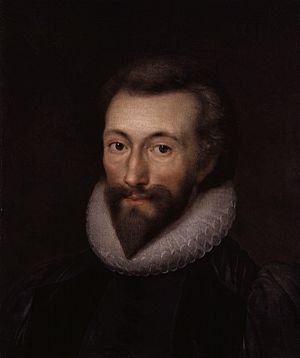Metaphysical poets facts for kids
The Metaphysical poets were a group of English poets who lived mostly in the 1600s. They are known for their very clever and sometimes difficult metaphors. These poets liked to explore big ideas about life, love, and faith in their poems. John Donne is probably the most famous of them. Even though their poems were not always popular, writers like T. S. Eliot helped people see how important they are to English literature today.
Contents
Who Were the Metaphysical Poets?
The Metaphysical poets were active during the 17th century, a time of big changes in England. They were not a formal group, but they shared a similar style of writing. The word "metaphysical" means dealing with things that are beyond the physical world, like deep thoughts about existence, God, or the soul.
Some of the most well-known Metaphysical poets include:
They often wrote about serious topics, but they did it in a very smart and sometimes surprising way.
What Makes Their Poetry Unique?
Metaphysical poetry stands out because of several special features:
Clever Comparisons (Conceits)
One of the most famous things about Metaphysical poetry is the use of "conceits." A conceit is a very long and clever metaphor or comparison that links two very different things. For example, John Donne once compared two lovers to the two legs of a compass. This kind of comparison makes you think hard and see things in a new way.
Wit and Deep Thinking
These poets loved to show off their intelligence. Their poems are full of wit, which means they are smart and often surprising. They used logic and arguments in their poems, almost like a lawyer trying to prove a point. This made their poetry very intellectual and thought-provoking.
Everyday Language
Unlike some poets who used very fancy words, Metaphysical poets often used words that people spoke every day. This made their poems feel more direct and personal. They mixed everyday speech with deep ideas, which was quite new for their time.
Big Themes
The Metaphysical poets explored many important themes in their work. They wrote about:
- Love and relationships
- Religion and faith
- Death and what happens after life
- The human soul and its connection to God
- The mysteries of the universe
They often looked at these themes from many different angles, showing their complex thoughts.
Famous Metaphysical Poets
Many poets are considered part of this group, each with their own unique voice.
John Donne
John Donne (1572–1631) is often seen as the leader of the Metaphysical poets. He started his career as a lawyer and later became a priest. His poems are known for being very passionate and intellectual. He wrote about both romantic love and his deep religious faith. His "Holy Sonnets" are famous for exploring his struggles and beliefs about God.
George Herbert
George Herbert (1593–1633) was also a priest, and his poems are mostly about his strong faith and devotion to God. His writing is often calmer and more peaceful than Donne's, but still very clever. He used everyday objects and situations to explain spiritual ideas.
Andrew Marvell
Andrew Marvell (1621–1678) was a poet and also a politician. His poems are known for their wit and sometimes playful tone. He wrote about nature, love, and political events. One of his most famous poems, "To His Coy Mistress," is a classic example of Metaphysical wit.
Why Are They Important Today?
For a long time after their deaths, the Metaphysical poets were not very popular. Some critics thought their poems were too difficult or strange. However, in the early 20th century, writers like T. S. Eliot helped people rediscover their work. Eliot admired their intelligence and their ability to combine deep thought with strong feelings.
Today, the Metaphysical poets are highly valued in English literature. They are studied in schools and universities because of their unique style, their deep ideas, and their lasting influence on poetry. They showed that poetry could be smart, emotional, and surprising all at the same time.
Images for kids
See also
 In Spanish: Poesía metafísica para niños
In Spanish: Poesía metafísica para niños




